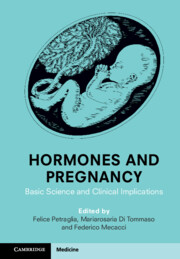Book contents
- Hormones and Pregnancy
- Hormones and Pregnancy
- Copyright page
- Contents
- Contributors
- Section I Hormones in the Physiology and Pharmacology of Pregnancy
- Section II Hormones and Gestational Disorders
- Chapter 8 Prolactin, Prolactinoma, and Pregnancy
- Chapter 9 Growth Hormone Disorders in Pregnancy
- Chapter 10 Gestational Diabetes
- Chapter 11 Obesity and Metabolic Syndrome in Pregnancy
- Chapter 12 Hormones and Pre-term Birth
- Chapter 13 Thyroid Dysfunction in Pregnancy and Postpartum
- Chapter 14 The Role of Hormones in Hypertensive Disorders of Pregnancy
- Chapter 15 Adrenal Disease in Pregnancy
- Chapter 16 Hormones and Multiple Pregnancy
- Chapter 17 Hormones in Pregnancy and the Developmental Origins of Health and Disease
- Index
- References
Chapter 11 - Obesity and Metabolic Syndrome in Pregnancy
from Section II - Hormones and Gestational Disorders
Published online by Cambridge University Press: 09 November 2022
- Hormones and Pregnancy
- Hormones and Pregnancy
- Copyright page
- Contents
- Contributors
- Section I Hormones in the Physiology and Pharmacology of Pregnancy
- Section II Hormones and Gestational Disorders
- Chapter 8 Prolactin, Prolactinoma, and Pregnancy
- Chapter 9 Growth Hormone Disorders in Pregnancy
- Chapter 10 Gestational Diabetes
- Chapter 11 Obesity and Metabolic Syndrome in Pregnancy
- Chapter 12 Hormones and Pre-term Birth
- Chapter 13 Thyroid Dysfunction in Pregnancy and Postpartum
- Chapter 14 The Role of Hormones in Hypertensive Disorders of Pregnancy
- Chapter 15 Adrenal Disease in Pregnancy
- Chapter 16 Hormones and Multiple Pregnancy
- Chapter 17 Hormones in Pregnancy and the Developmental Origins of Health and Disease
- Index
- References
Summary
Increasing numbers of women who are pregnant have a body mass index exceeding >30 kg/m2, the definition of obesity. The obese condition is associated with a number of adverse outcomes among mothers and offspring. Offspring are at greater risk for adult onset diseases, including obesity compared to babies born to women in the normal BMI category. The risk of mortality in offspring caused by ischemic heart disease increases linearly by three-fold between a BMI of 25 to 30 kg/m2. Women with obesity are less likely to breastfeed than normal weight women. An important aspect of the obese condition is an altered range of weight around which the body regulates appetite. The medical management of women who suffer obesity can include attention to a number of factors including lifestyle modifications. Importantly, eating a healthy diet during pregnancy has been shown to improve perinatal outcomes in women across the BMI spectrum.
- Type
- Chapter
- Information
- Hormones and PregnancyBasic Science and Clinical Implications, pp. 107 - 119Publisher: Cambridge University PressPrint publication year: 2022

